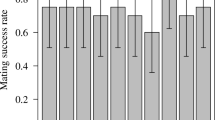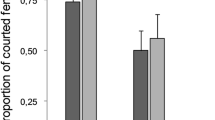Abstract
To understand how the diversity among male sexual traits is maintained despite directional female choice for attractive traits, it is important to study male reproductive success in each reproductive episode. Male reproductive success is indeed the comprehensive result of several processes such as mate choice, mating, and fertilization. In this study, male mating success was estimated in a wild guppy Poecilia reticulata population of Hiji River, Okinawa Island, in southern Japan. The mating success of males was estimated as the percentage of sperm transferred in relation to the total sperm reserve. In a preliminary experiment, it was confirmed that the sperm reserves of males were partly replenished after 12 h and fully replenished after 72 h, when all sperm were released. In addition, the results of investigation in the wild population revealed that approximately 20% of males had no sperm reserves at all, although their sperm reserves should have been replenished by sexual isolation. Male sexual traits such as body size or color pattern did not affect the percentage of sperm transferred. Results from this study provide important insights into male sperm transfer ability and sperm production in this population. However, the high frequency of male sperm-transfer success estimated in this study should to be taken with caution, and whether it is due to differences between wild and laboratory conditions, sex ratio or the rates of multiple matings by females in the wild population remain to be fully explored.


Similar content being viewed by others
References
Auld HL, Pusiak RJ, Godin JGJ (2016) Independent mating preferences for male body size and coloration in female Trinidadian guppies. Ethology 122:597–608
Clutton-Brock TH (1988) Reproductive success: studies of individual variation in contrasting breeding systems. University of Chicago Press, Chicago
Eberhard WG (1996) Female control: sexual selection by cryptic female choice. Princeton University Press, Princeton
Elgee KE, Evans JP, Ramnarine IW, Rush SA, Pitcher TE (2010) Geographic variation in sperm traits reflects predation risk and natural rates of multiple paternity in the guppy. J Evol Biol 23:1331–1338
Evans JP, Bisazza A, Pilastro A (2004a) Female mating preferences for colourful males in a population of guppies subject to high predation. J Fish Biol 65:1154–1159
Evans JP, Kelley JL, Bisazza A, Finazzo E, Pilastro A (2004b) Sire attractiveness influences offspring performance in guppies. Proc R Soc Lond B 271:2035–2042
Evans JP, Zane L, Francescato S, Pilastro A (2003) Directional postcopulatory sexual selection revealed by artificial insemination. Nature 421:360–363
Gasparini C, Dosselli R, Evans JP (2017) Sperm storage by males causes changes in sperm phenotype and influences the reproductive fitness of males and their sons. Evol Lett 1:16–25
Gasparini C, Marino IAM, Boschetto C, Pilastro A (2010) Effect of male age on sperm traits and sperm competition success in the guppy (Poecilia reticulata). J Evol Biol 23:124–135
Grether GF, Kolluru GR, Rodd FH, De la Cerda J, Shimazaki K (2005) Carotenoid availability affects the development of a colour-based mate preference and the sensory bias to which it is genetically linked. Proc R Soc Lond, B, Biol Sci 272:2181–2188
Houde, AE (1997) Sex, color, and mate choice in guppies. Princeton University Press, Princeton
Karino K, Matsunaga J (2002) Female mate preference is for male total length, not tail length in feral guppies. Behaviour 139:1491–1508
Karino K, Shimada Y, Kudo H, Sato A (2010) Relative importance of the area and intensity of the orange spots of male guppies Poecilia reticulata as mating traits preferred by females. J Fish Biol 77:299–307
Karino K, Urano Y (2008) The relative importance of orange spot coloration and total length of males in female guppy mate preference. Environ Biol Fishes 83:397–405
Kuckuck C, Greven H (1997) Notes on the mechanically stimulated discharge of spermiozeugmata in the guppy, Poecilia reticulata: a quantitative approach. Z Fischk 4:73–88
Kudo H, Karino K (2013) Negative correlation between male ornament size and female preference intensity in a wild guppy population. Behav Ecol Sociobiol 67:1931–1938
Magurran AE. (2005) Evolutionary ecology: the Trinidadian guppy. Oxford University Press, Oxford
Matthews IM, Evans JP, Magurran AE (1997) Male display rate reveals ejaculate characteristics in the Trinidadian guppy Poecilia reticulata. Proc R Soc Lond, B 264:695–700
Matthews IM, Magurran AE (2000) Evidence for sperm transfer during sneaky mating in wild Trinidadian guppies. J Fish Biol 56:1381–1386
Millar NP, Hendry AP (2012) Population divergence of private and non-private signals in wild guppies. Environl Biol Fishes 94:513–525
Neff BD, Pitcher TE, Ramnarine IW (2008). Inter-population variation in multiple paternity and reproductive skew in the guppy. Mol Ecol 17:2975–2984
Parker GA (1970) Sperm competition and its evolutionary consequences in insects. Biol Rev 45:525–567
Pitcher TE, Evans JP (2001) Male phenotype and sperm number in the guppy (Poecilia reticulata). Can J Zool 79:1891–1896
Pilastro A, Bisazza A (1999) Insemination efficiency of two alternative male mating tactics in the guppy Poecilia reticulata. Proc R Soc Lond, B, Biol Sci 266:1887–1891
Pilastro A, Simonato M, Bisazza A, Evans JP (2004) Cryptic female preference for colorful males in guppies. Evolution 58:665–669
Schwartz AK, Hendry AP (2007) A test for the parallel co-evolution of male colour and female preference in Trinidadian guppies (Poecilia reticulata). Evol Ecol Res 9:71–90
Schwartz A K, Hendry AP (2010) Testing the influence of local forest canopy clearing on phenotypic variation in Trinidadian guppies. Funct Ecol 24:354–364
Sato A, Karino K (2006) Use of digitally modified videos to examine female mate preference for orange spot coloration of males in the guppy, Poecilia reticulata. Ichthyol Res 53:398–405
Sato A, Karino K (2011) Offspring sex ratio produced by female guppies in the wild correlates with sexual ornaments of their sons. J Ethol 29:221–226
Sato A, Karino K (2017) Evidence for Strategic Sex Allocation in the Guppy (Poecilia reticulata): Brood Sex Ratio and Size Predict Subsequent Adult Male Mating Success. Ethology 123:221–229
Acknowledgments
I would like to thank Kobayashi T and Sakiyama M for collecting the experimental fishes. I am grateful to Karino K for giving insightful comments and suggestions on the manuscript, and to the anonymous reviewers for their useful comments on an earlier version of the manuscript. This study was partially supported by the Grant-in-Aid for Research Activity Start-up in Program for Promoting the Reform of National Universities.
Author information
Authors and Affiliations
Corresponding author
About this article
Cite this article
Sato, A. Mating success of male guppy Poecilia reticulata in the wild. Ichthyol Res 65, 231–236 (2018). https://doi.org/10.1007/s10228-017-0610-7
Received:
Revised:
Accepted:
Published:
Issue Date:
DOI: https://doi.org/10.1007/s10228-017-0610-7




